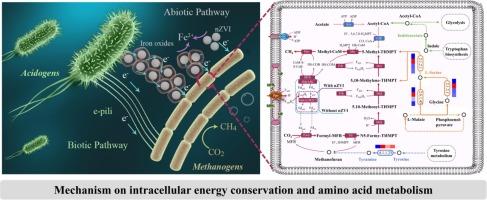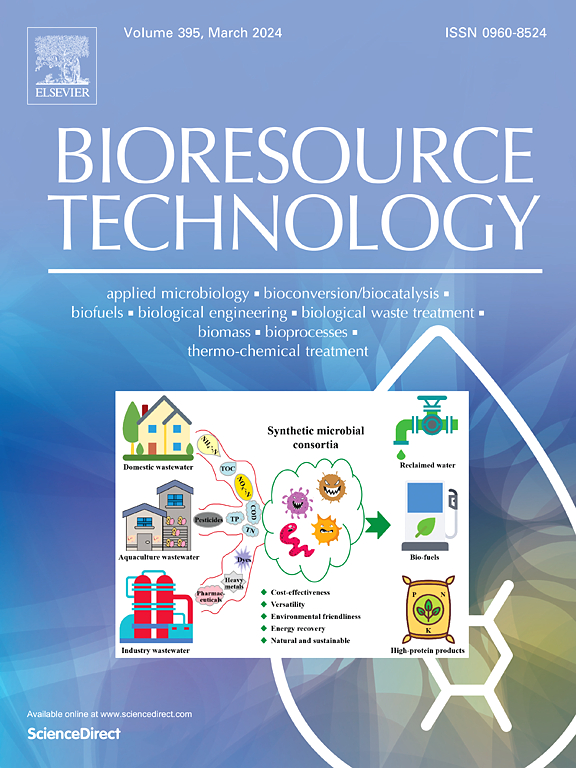Enhanced methanogenesis of wastewater anaerobic digestion by nanoscale zero-valent iron: Mechanism on intracellular energy conservation and amino acid metabolism
IF 9
1区 环境科学与生态学
Q1 AGRICULTURAL ENGINEERING
引用次数: 0
Abstract
Nanoscale zero-valent iron (nZVI)-mediated anaerobic digestion commonly focuses on electron transfer between syntrophic bacteria, neglecting intracellular energy conservation strategies and amino acid metabolism. In this study, F420H2 dehydrogenase abundance increased by 5.1 %, 27.0 %, and 31.5 % at 10 mM, mM, 30 mM, and 50 mM nZVI dosing, respectively, enabling an efficient transmembrane proton-coupled electron transfer mode. Electron bifurcation (EB) enzymes involved in methanogenesis responded differently to nZVI, with HdrA2B2C2 initially increasing at 10 mM and decreasing at 30 mM and 50 mM, while MvhADG-HdrABC was completely down-regulated. Metabolomics further demonstrated that nZVI reduced riboflavin and flavin mononucleotide content, which is detrimental to the EB. Instead, an alternative measure to maintain electron flow and energy conservation under high nZVI exposure is high expression of ndh and F-type or V/A-type ATPase genes. Additionally, enhancing C1-unit carrier expression through amino acid metabolism regulation emerged as a key strategy. This study provides new perspectives on nZVI-mediated anaerobic digestion.

纳米级零价铁促进废水厌氧消化产甲烷:细胞内能量节约和氨基酸代谢机制。
纳米级零价铁(nZVI)介导的厌氧消化通常侧重于合成细菌之间的电子转移,而忽略了细胞内的能量守恒策略和氨基酸代谢。在本研究中,F420H2脱氢酶丰度在10 30和50 mM nZVI剂量下分别增加了5.1 %,27.0 %和31.5 %,实现了高效的跨膜质子耦合电子转移模式。参与甲烷生成的电子分叉(EB)酶对nZVI的反应不同,HdrA2B2C2在10 mM时初始升高,在30和50 mM时降低,而MvhADG-HdrABC则完全下调。代谢组学进一步表明,nZVI降低了核黄素和黄素单核苷酸的含量,对EB有害。相反,在高nZVI暴露下维持电子流和能量守恒的另一种方法是ndh和f型或V/ a型atp酶基因的高表达。此外,通过氨基酸代谢调节提高c1载体表达成为关键策略。该研究为nzvi介导的厌氧消化提供了新的视角。
本文章由计算机程序翻译,如有差异,请以英文原文为准。
求助全文
约1分钟内获得全文
求助全文
来源期刊

Bioresource Technology
工程技术-能源与燃料
CiteScore
20.80
自引率
19.30%
发文量
2013
审稿时长
12 days
期刊介绍:
Bioresource Technology publishes original articles, review articles, case studies, and short communications covering the fundamentals, applications, and management of bioresource technology. The journal seeks to advance and disseminate knowledge across various areas related to biomass, biological waste treatment, bioenergy, biotransformations, bioresource systems analysis, and associated conversion or production technologies.
Topics include:
• Biofuels: liquid and gaseous biofuels production, modeling and economics
• Bioprocesses and bioproducts: biocatalysis and fermentations
• Biomass and feedstocks utilization: bioconversion of agro-industrial residues
• Environmental protection: biological waste treatment
• Thermochemical conversion of biomass: combustion, pyrolysis, gasification, catalysis.
 求助内容:
求助内容: 应助结果提醒方式:
应助结果提醒方式:


